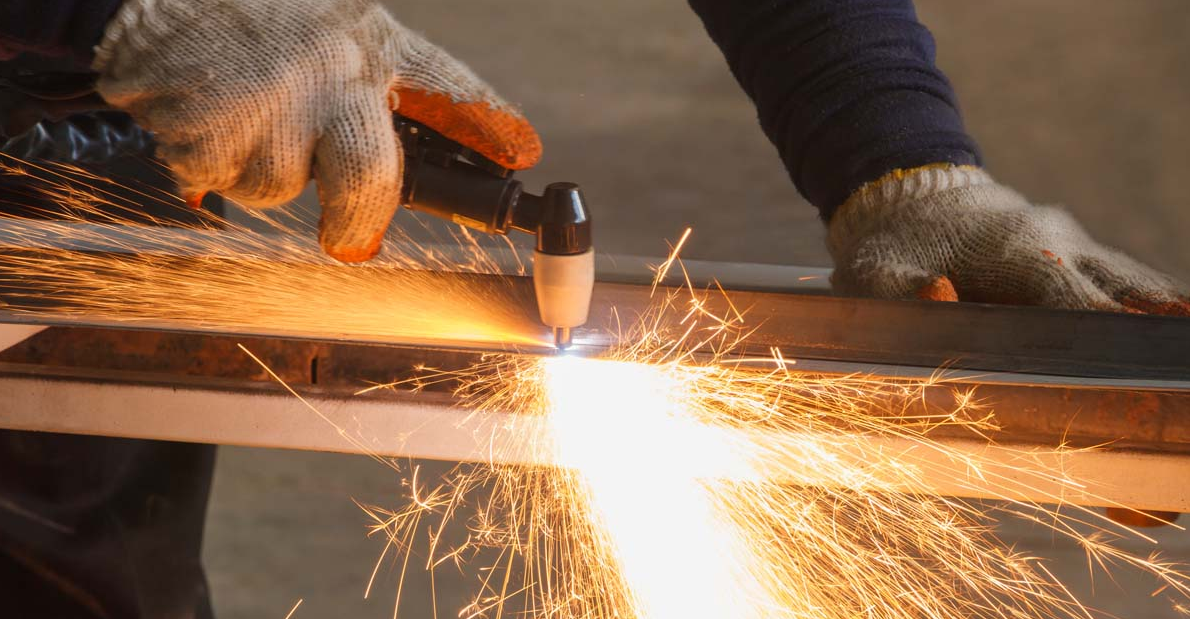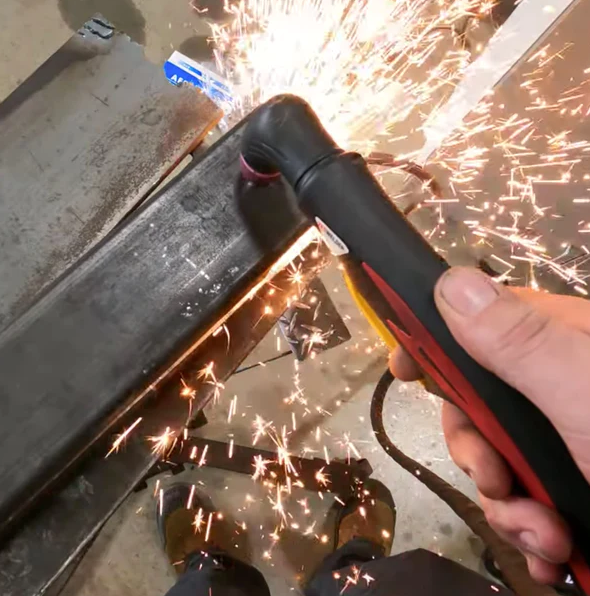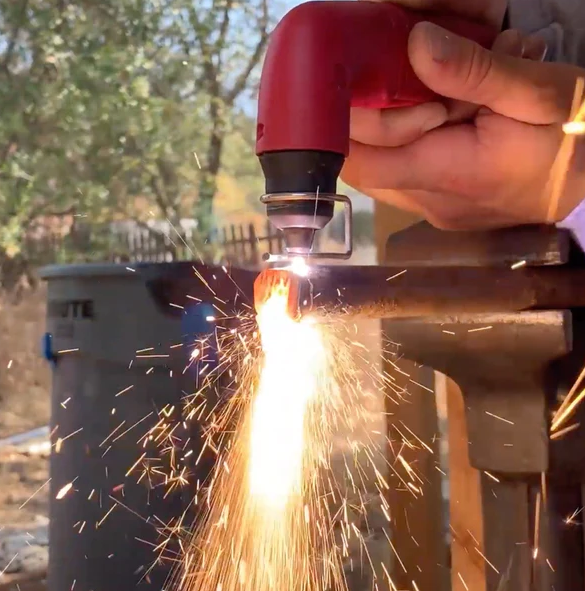Plasma cutting offers high cutting speed, versatility across various materials and thicknesses, and exceptional precision and quality.
Introduction
The process of plasma cutting has revolutionized the way industries cut metal and other electrically conductive materials. This Introduction aims to offer readers an in-depth look at what plasma cutting is, how it came into existence, and the common applications where it shows its strengths.

Definition of Plasma Cutting
Plasma cutting is a process that cuts through electrically conductive materials by means of an accelerated jet of hot plasma. Essentially, it uses a high-velocity stream of ionized gas to cut through materials like steel, aluminum, copper, and brass. The basic setup includes a power supply, an arc-starting circuit, and a torch. Unlike traditional cutting methods, plasma cutting allows for quick and precise cutting operations.
Here, it’s worth mentioning that the term “plasma” refers to a state of matter where the gas gets so hot that it becomes ionized. This ionized gas is capable of conducting electricity, which is what makes plasma cutting so effective. To know more about plasma, you can visit its Wikipedia page.
Brief History of Plasma Cutting
The concept of plasma cutting originated in the 1960s as a part of the plasma welding process. It gained rapid acceptance in industrial applications due to its efficiency and versatility. Initially, it was a costly operation limited to specialized fields such as aerospace and automotive industries. However, technological advancements have made plasma cutting a more accessible and economical choice for various sectors.
The history of plasma cutting is one of innovation and adaptation. Companies have continually refined the technology, making it more reliable, safer, and easier to use. For a comprehensive history of plasma cutting, you can read the Wikipedia page dedicated to Plasma Cutting.
Common Applications
Plasma cutting sees extensive use across a variety of sectors. It plays a crucial role in:
Automotive Manufacturing: For cutting and shaping auto parts.
Construction: Especially in steel structure buildings.
Shipbuilding: For accurate cuts in complex designs.
Metal Art: Where precision and speed are essential.
Industrial Fabrication: Where mass production requires both speed and consistency.
Its versatility in cutting different materials and complex shapes makes it an indispensable tool in modern manufacturing and construction.
Advantage 1: High Cutting Speed
One of the most notable benefits of plasma cutting is its impressive speed. This attribute not only makes it a preferred choice for many industries but also leads to significant cost savings in large-scale operations. Let’s delve into why and how plasma cutting stands out in terms of speed.
Comparison with Other Cutting Methods
When we stack plasma cutting against other methods, the differences are striking. Traditional oxy-fuel cutting heats up the metal, which then reacts with oxygen to make the cut. This process, while effective, can be slow, especially on thicker metals. On the other hand, mechanical methods like saw cutting might be efficient for straight lines but can falter with complex shapes.
Plasma cutting, due to its use of ionized gas, can move through metal at speeds unimaginable with other methods. For instance, while an oxy-fuel cutter might manage a speed of 8 inches per minute on a half-inch steel plate, a plasma cutter can blaze through the same material at 50 inches per minute or even faster. Those interested in a detailed comparison can find more information on the Wikipedia page for cutting processes.
Importance in Industrial Settings
In industries where production timelines are tight, and efficiency is paramount, the high speed of plasma cutting proves invaluable. Here’s how:
Mass Production: In factories producing large quantities of metal parts, the speed of plasma cutting accelerates production rates, meeting consumer demands faster.
Reduced Operational Costs: Faster cutting means fewer operational hours, which translates to savings in labor costs and energy bills.
Less Thermal Distortion: Since plasma cutting is quicker, there’s less heat exposure to the surrounding areas of the metal, resulting in reduced warping and deformation.
Increased Throughput: A single plasma cutting setup can achieve what multiple traditional setups might take to accomplish, leading to increased throughput.
Advantage 2: Versatility
The second compelling advantage of plasma cutting is its sheer versatility. Unlike some cutting methods that excel in only one or two types of materials, plasma cutting shines across a wide range of materials and applications. Let’s explore this multifaceted quality in more detail.
Range of Materials
Plasma cutting is highly adaptable when it comes to the materials it can cut. The process can tackle:
Ferrous Metals: Such as mild steel and stainless steel.
Non-Ferrous Metals: Including aluminum, copper, and brass.
Other Conductive Materials: Such as certain types of composites.
For a more comprehensive list of conductive materials and their properties, you can visit the Wikipedia page on electrically conductive materials.
Thickness Capability
One remarkable aspect of plasma cutting is its adaptability to material thickness. From sheet metal as thin as 0.5mm to plates up to 50mm or more, plasma cutting provides a wide range of operational flexibility. This allows industries to utilize the same cutting technique across various stages of production and for different components.
Shape and Design Flexibility
Plasma cutting isn’t just limited to straight lines. Whether you need to cut out intricate designs, circles, or angled shapes, plasma cutting is up to the task. Its ability to handle complex geometric configurations makes it invaluable in fields like:
Automotive Design: For intricate parts and components.
Sculpture and Metal Art: Where artistic expression requires complex shapes.
Architectural Elements: For custom metal fixtures and detailing.

Advantage 3: Precision and Quality
The third critical advantage that distinguishes plasma cutting from its competitors is the level of precision and quality it can achieve. While speed and versatility are crucial, they would mean little without a commensurate level of accuracy and excellence in the final product. Here’s why plasma cutting scores high in these aspects.
Kerf Width
In the world of cutting, the “kerf” refers to the width of the material removed during the cutting process. A narrower kerf means less waste and a more precise cut. Plasma cutting excels here by offering an incredibly narrow kerf, which not only minimizes material waste but also allows for more intricate designs. To learn more about kerf and its relevance in material science, you can check out its Wikipedia entry.
Heat-Affected Zone
One downside to many cutting methods is the “Heat-Affected Zone” (HAZ), the area of the material that experiences changes in its properties due to heat exposure. A smaller HAZ is preferable because it results in less warping and structural weakening. Plasma cutting stands out by minimizing the HAZ, thereby maintaining the integrity of the material. More details about the Heat-Affected Zone can be found on its Wikipedia page.
Surface Finish
The quality of the surface finish is a significant factor, especially in industries like automotive manufacturing and aerospace, where every imperfection can have a substantial impact. Plasma cutting offers a smoother surface finish compared to many other methods, reducing the need for secondary finishing operations, thus saving both time and resources.
Additional Benefits
While the primary advantages of plasma cutting lie in its speed, versatility, and precision, there are other noteworthy benefits that contribute to its growing popularity. These include cost-efficiency and the built-in safety features that modern plasma cutting systems offer.

Cost-Efficiency
Plasma cutting technology has been evolving, and one of the most striking improvements is its growing cost-efficiency. Initial setup costs have come down considerably thanks to technological advancements, making it more accessible for smaller operations and hobbyists.
Furthermore, the speed and precision of plasma cutting mean fewer wasted materials and quicker project completion, which translates into cost savings. Businesses, whether big or small, appreciate this because it directly impacts the bottom line. For a detailed analysis of cost-efficiency in manufacturing processes, the Wikipedia page on Cost Efficiency provides ample information.
Safety Features
Modern plasma cutting systems come equipped with a variety of safety features designed to protect the operator. These can include:
Fume Extraction Systems: To remove harmful fumes generated during cutting.
Emergency Stop Buttons: For immediate system shutdown in case of an emergency.
Cooling Systems: To prevent overheating of the torch and other components.




